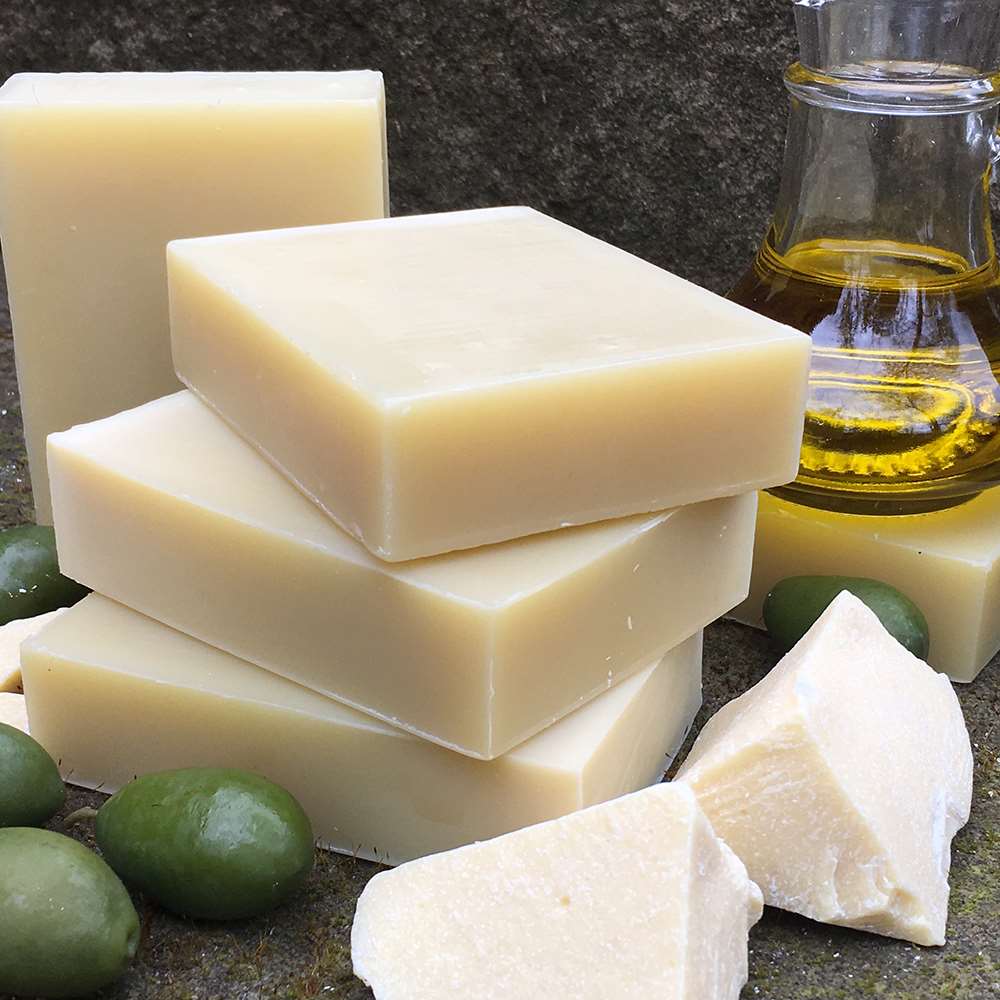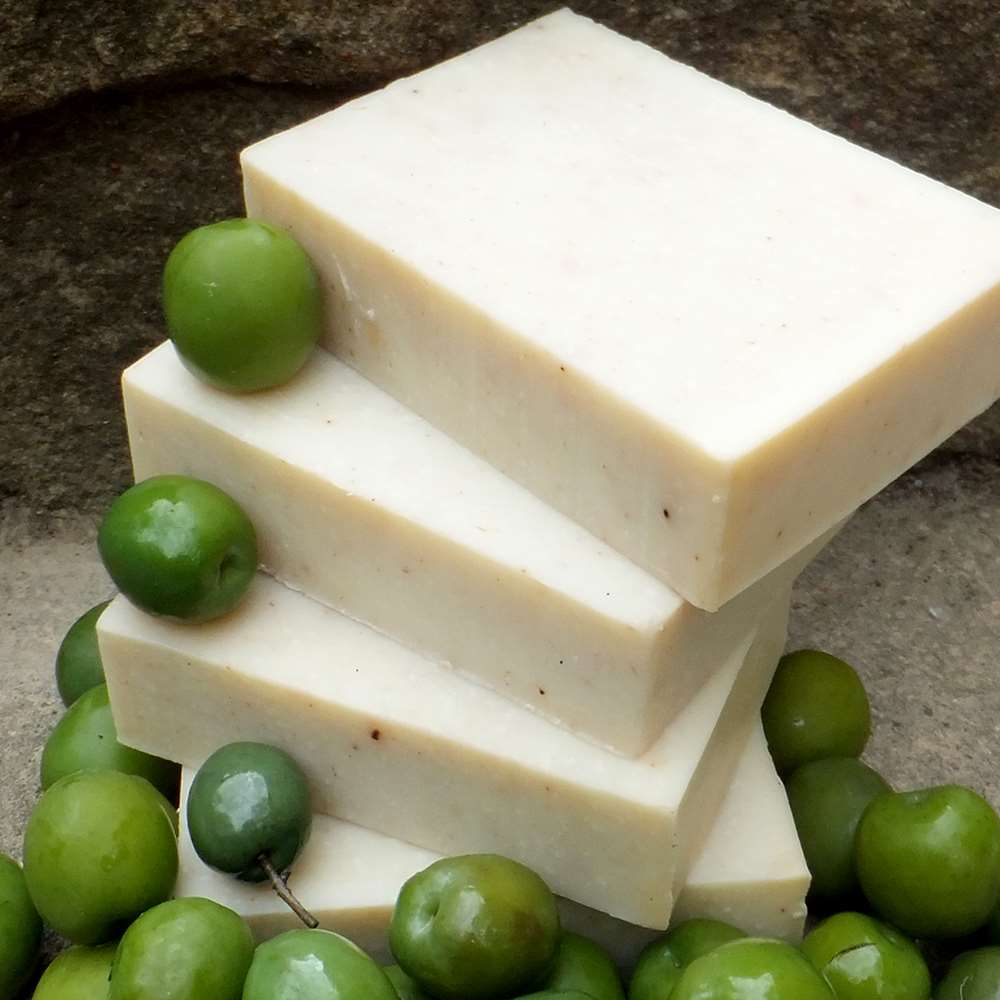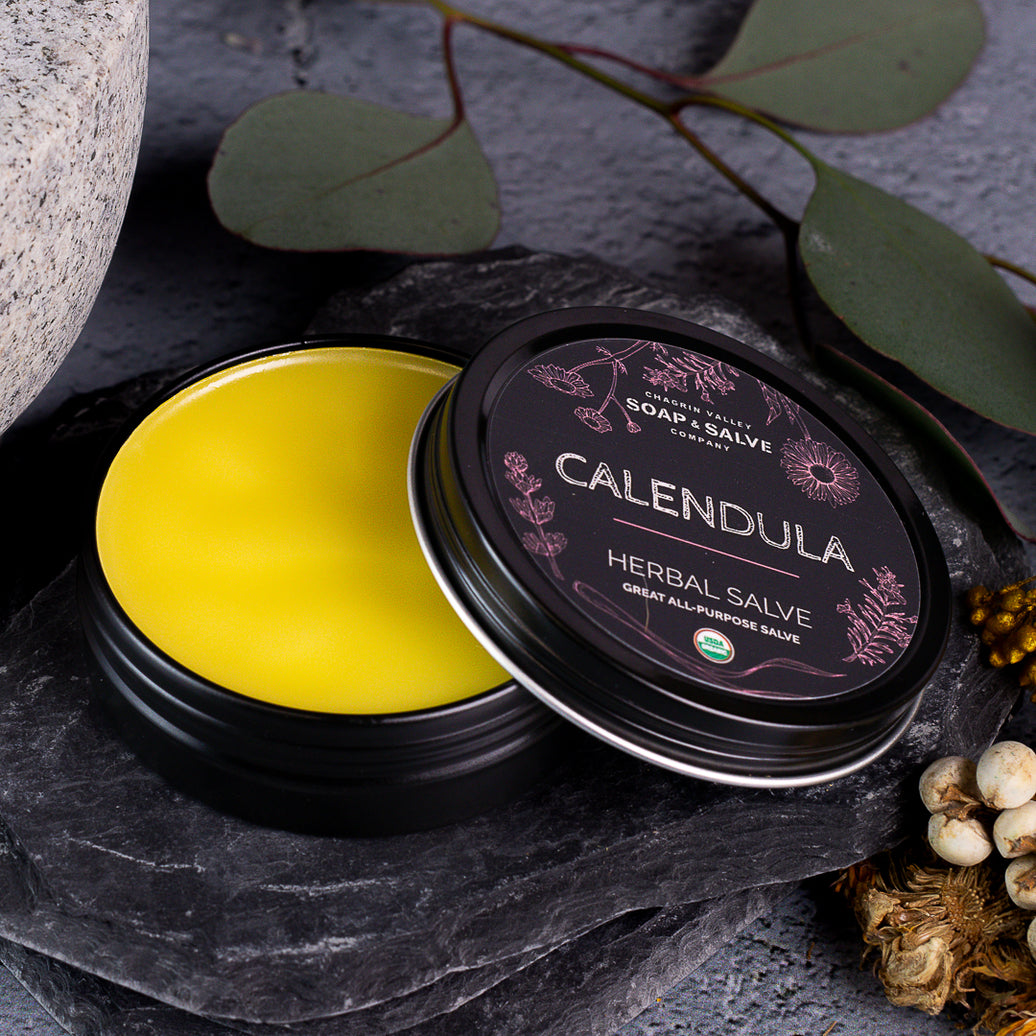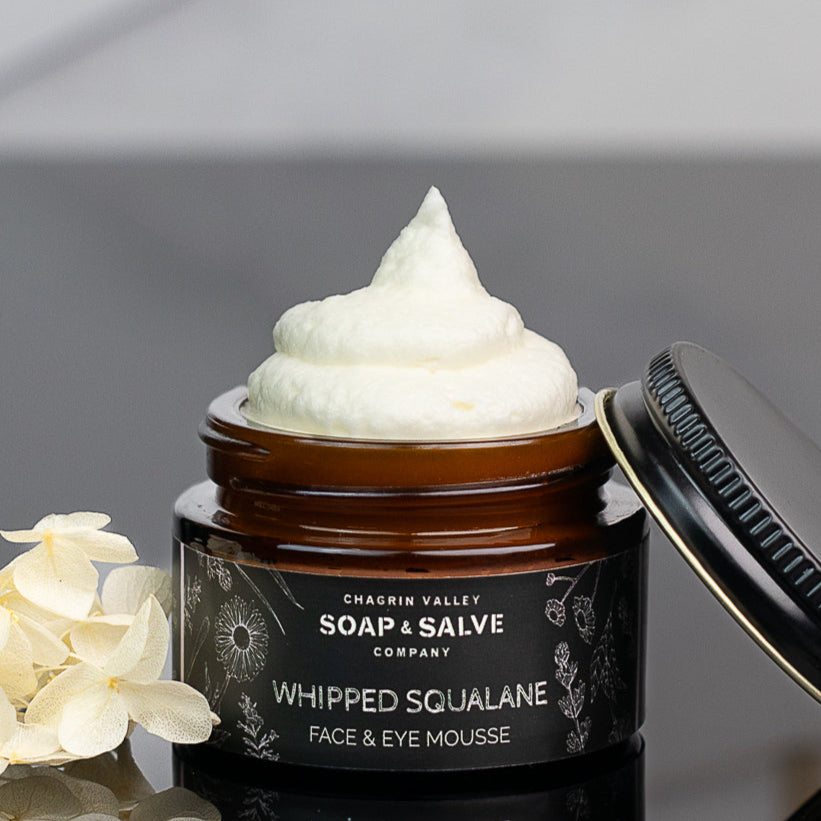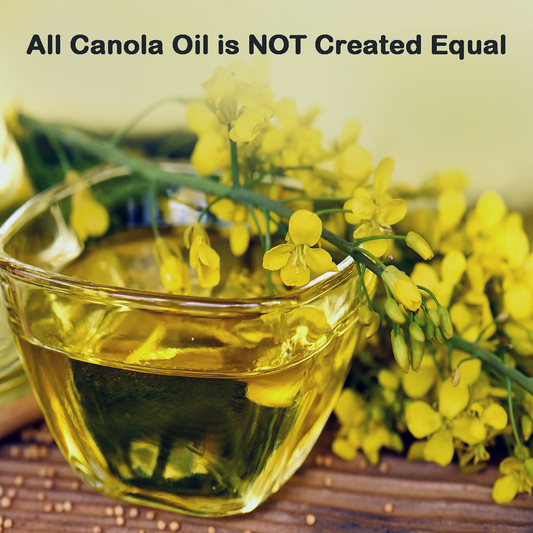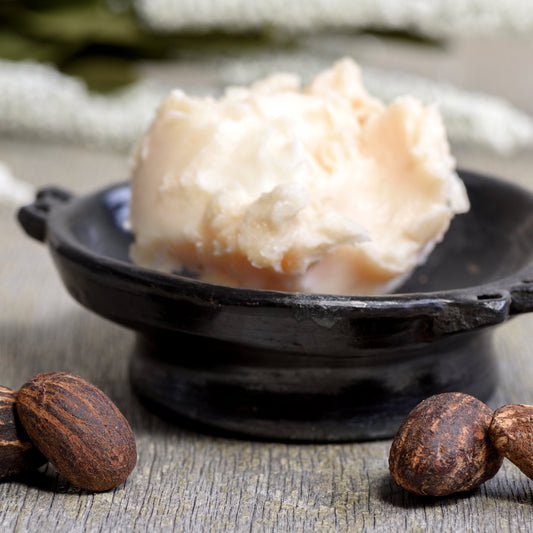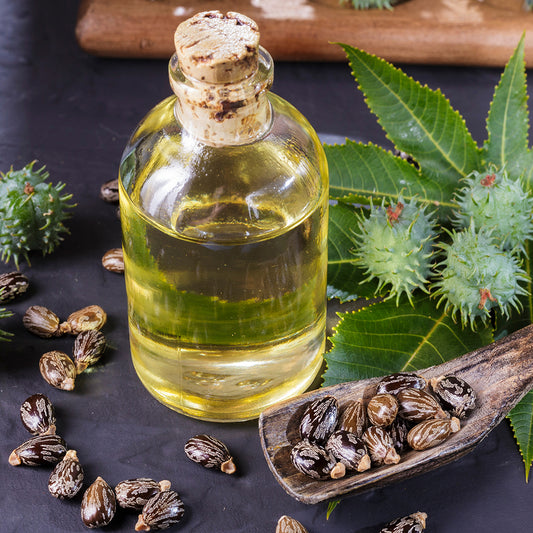Olive Oil Tutorial: All Olive Oils Are Not Created Equal
Olive oil, one of our favorite oils here at Chagrin Valley Soap & Salve, is a common base oil used in soap making.
The type of fatty acids in olive oil gives soap its rich moisturizing and mild cleansing properties. It creates a gentle soap that is ideal for sensitive skin types that are prone to dryness and irritation.

It makes a nice hard bar of soap, is very mild, and in combination with other oils, makes a nice dense lather. When used as the only oil in the soap, the lather is thick, slick, and creamy, rather than bubbly.
A quality organic extra virgin olive oil is also a great base for oil infusions used to make healing salves.
Slowly infusing herbs into the unrefined oil transfers the healing properties, scent, and color to the oil, and is one of the oldest forms of medicine-making.
We choose extra virgin olive oil because it retains the natural antioxidants, vitamins, minerals, and natural squalene found in olives.
The Story of Olive Oil
Olive trees thrive best in areas with rainy winters and hot, dry summers. Although it may take up to eight years before a tree produces its first harvest, a single tree can live for centuries.
Harvesting & Milling Olives
 The olives are usually harvested in late October and early November. Olive harvesting is done by hand picking, handshaking, or mechanical harvesting.
The olives are usually harvested in late October and early November. Olive harvesting is done by hand picking, handshaking, or mechanical harvesting.
After the olives are harvested, they are sorted according to their plumpness, state of ripeness, and quality. The olives are taken to the mill and stored for a short period of time, from a few hours to several days.
While some believe that the olives should be milled within twelve hours of harvesting (the faster the olives are processed the better), others keep the olives for a short period, short enough to prevent fermentation but long enough to allow the olives to get warm so that they release their oil more easily.
The olives are prepared for crushing by first separating the leaves, stems, and twigs from the olives and then rinsing them in cold water in order to rid them of any dirt.
The olives are then passed along a conveyer belt between rollers or continuous hammers, called the olive crusher, to help crack the olive pits and break down the cells to release the oil.
The next step is crushing the olives into a paste. In ancient times, the olives were crushed between huge cone-shaped stones as they turned slowly on a base of granite.
In the modern process, the milled olives travel from the mill into vats in which slowly turning blades mash the olives into a homogenized paste.
Extraction/Pressing Olives
 In the past, the olives were pressed between layers of woven mats by large corkscrew-type presses. The photo shows an ancient press in Italy.
In the past, the olives were pressed between layers of woven mats by large corkscrew-type presses. The photo shows an ancient press in Italy.
Today, the process is largely done by mechanical means using centrifuges to separate the olive pulp and water from the oil.
The term cold-pressing refers to the fact that the oil is extracted without heating the paste, furthering ensuring the purity of the oil. This is the oil that receives the appellation of "extra-virgin" olive oil.
The paste is removed from the bags and run through several more presses to obtain the lesser grades of oil that remain.
The solid material that remains after the extraction of the oil is called pomace, and it contains residual oil. Some manufacturers will use steam, hexane, or other solvents to squeeze more oil out of the pomace. This low-quality oil must be labeled as pomace oil.
The color of an olive oil has no bearing on its quality. Olive oil can range from yellow to gold to green. The hue is influenced by a variety of factors which include the type of olive, growing conditions, and the time of harvest.
The following factors can impact the taste of olive oil:
- type of olive used
- soil conditions
- the location where olives were grown
- the weather during the “growing” and “harvesting” seasons
- the ripeness of the olives
- season/timing of the harvest
- harvesting method
- length of time between the harvest and pressing
- pressing technique
- packaging and storage methods.
All Olive Oils are Not Created Equal
 Olive oil is "graded" according to its flavor, color, aroma, as well as its acidity, which is the most important criteria for determining the grade.
Olive oil is "graded" according to its flavor, color, aroma, as well as its acidity, which is the most important criteria for determining the grade.
The US is one of few countries that has not adopted the International Olive Oil Council (IOC) standards.
It has its own USDA olive oil grade standards, which were revised and became effective in October 25, 2010. The US recognizes eight types of olive oil:
- Extra Virgin Olive Oil (EVOO)
- Virgin Olive Oil (VOO)
- Lampante Virgin Olive Oil
- Refined Olive Oil
- Olive Oil
- Olive-Pomace Oil
- Refined Olive-Pomace Oil
- Crude Olive-Pomace Oil.
Olive oil is more commonly divided into only five main categories: Extra Virgin Olive Oil, Virgin Olive Oil, Refined Olive Oil, Olive-Pomace Oil, and Lampante Olive Oil.
While the written standards for the grades of olive oil can get quite complicated, very simply the differences correspond to the extraction and refining process.
Extra Virgin Olive Oil
Obviously, olive oil comes from olives. But the words “extra virgin” describe the quality of the olives used and the process in which the oil was produced. Extra virgin olive oil must be free from any alterations in color, taste, nutrients, or vitamins.
 Olive oil labeled Extra Virgin Olive Oil (EVOO) is an unrefined oil meaning it is less processed than the other varieties. EVOO, produced from the fruit of the entire olive, is considered the finest and fruitiest olive oil and also the most expensive. It can range from pale yellow to greenish-gold to bright green in color and it retains a more true olive taste.
Olive oil labeled Extra Virgin Olive Oil (EVOO) is an unrefined oil meaning it is less processed than the other varieties. EVOO, produced from the fruit of the entire olive, is considered the finest and fruitiest olive oil and also the most expensive. It can range from pale yellow to greenish-gold to bright green in color and it retains a more true olive taste.
EVOO comes from the first press which basically means the fruit of the olive was pressed (ground) exactly one time and the temperature during processing was less than 81 degrees Fahrenheit.
While "regular" olive oil is refined and may lose many of the nutrients and antioxidants found in olives, the first pressing extraction process used to produce Extra Virgin Olive Oil ensures it retains all the nutrients and antioxidants from the olive fruit.
Remember that "extra virgin" is based on a series of requirements and that quality and taste may differ based on the manufacturer and the type of extra virgin olive oil. In some countries, you can buy "Virgin" Olive Oil which is simply Extra Virgin Olive oil that has minimal defects and does not meet the standards of Extra Virgin.
Refined Olive Oil
At the end of a typical mechanical pressing to create "Extra Virgin" or "Virgin" Olive Oil," not all of the oil has been extracted from the olives. The remaining oil is often usually extracted by a mechanical "refining" process but may also use solvents and high heat in order to extract as much oil out of the olive as possible.
Since the solvents and high heat make the oils odorless and tasteless, this process also allows producers to use olives that are not in the best condition.
Olive Oil
Olive oils labeled simply "Olive Oil" or "Pure Olive Oil" are blends of refined and unrefined oils. This grade of oil actually represents the majority of olive oil sold on the world market to the consumer.
Blends are made in proportions to create specific styles and prices. Olive oil grades in the US labeled as “Extra Light” would most likely be a blend dominated by refined olive oil. Other blends with more color and flavor would contain more virgin or extra virgin olive oil.
Pomace Olive Oil
Solvent extracted olive pomace oil is the lowest grade of olive oil and is often used in making soap. It has the cheapest cost in comparison to the other grades. Pomace Oil is a greenish oil, produced from the pulp and leftover flesh (pulp) of the olives after the first press is done creating Extra Virgin Olive Oil.
The problem is that the first pressings take out most of the oil and the amount of oil contained in this leftover pomace, which consists of the solid remains of the olive including skins, pulp, seeds, and stems, cannot be extracted by pressing, but only through the combined use of chemical solvents and very high heat.
This process is usually done using a solvent called hexane. The hexane is added, which causes the last of the oil to come out of the dry pulp. Then the hexane is removed.
While pomace oil is not devoid of nutritional value, it is missing some healthy polyphenols, sterols and squalene that are found extra virgin oil.
Benefits of Extra Virgin Olive Oil (EVOO) for Skin
From moisturizing dry skin patches to fighting hair damage and taming frizz and flyaways, olive oil is brimming with skin benefits. Olive oil has been used for skin care for centuries. Apparently even Cleopatra was belived was an olive oil enthusiast.
Protects and Hydrates Even the Most Sensitive Skin
 The main benefit of Olive is to moisturize the skin by reducing water loss.
The main benefit of Olive is to moisturize the skin by reducing water loss.
EVOO attracts external moisture, holds the moisture close to the skin, and forms a breathable film to prevent loss of internal moisture. As skin hydration increases the health and appearance of the skin also improves. Since the fat composition of olive oil is very similar to that of human skin, it rarely causes allergic reactions, is great for all skin types, and does not block the natural functions of the skin.
Promotes Youthful Looking Skin
Olive oil is rich in vitamins A, D, K, and E, as well as squalene which can help minimize oxidative stress on the skin, which can lead to accelerated skin aging. Olive oil is believed to have healing properties and helps keeps skin soft, supple, and younger-looking.
Contains Natural Squalene
It is naturally high in squalene, a lipid naturally produced by the sebaceous (oil) glands in our skin. Unfortunately, our skin production of squalene decreases with age. EVOO is rich this wonderful natural emolient that boosts hydration and strengthens skin cells which can help skin appear more vibrant and healthier. While EVOO is great for all skin types including sensitive skin, the moisturizing properties of natural squalene are especially helpful for those with dry and/or mature skin.
Guards Against Environmental Damage
Olive oil is also full of antioxidants that work hard to fight environmental skin damage which can lead to irritation, inflammation and redness as well premature aging.
Great For Hair Care
Olive oil has been use for centuries in hot oil treatments to help repair split ends, control dandruff, and promote shiny, silky, and lustrous hair.
Conclusion
Olive oil is an invaluable source of health care benefits whether used in cooking or skin care. Extra virgin olive oil is olive oil that is unrefined, allowing it to retrain its full flavor profile and nutritional properties.
Unfortunately, seeing the words "olive oil" in an ingredient list, tell you nothing about the quality of the oil being used to make the soap, salve, or other skin care product.
At Chagrin Valley, we choose all of our ingredients by selecting the highest quality options. Lower quality olive oil will never be a good fit for our company.
At Chagrin Valley, the olive oil we use is cold-pressed and USDA Certified Organic Extra Virgin Olive Oil because it retains all the nutrients and antioxidants from the olive fruit.
